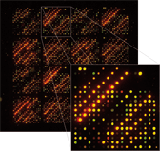One focus of molecular diagnostics at the Fraunhofer IGB is the development of microarray-based diagnostics. DNA chips for the classification of mammary carcinoma, for example, enable personalized and efficient therapy and prognosis. In addition, using molecular-genetic methods, we are developing improved diagnostic arrays for non-Hodgkin lymphoma. Another field of molecular diagnostic activity at the Fraunhofer IGB is the chip-based diagnosis of infections, which, according to the World Health Organization, are among the most frequent causes of death.
Molecular diagnostics: Chip for diagnosing sepsis
Indication sepsis

Sepsis, commonly known as blood poisoning, can be described as an infection getting out of control and is characterized by a complicated and life-threatening clinical pattern. It is caused by the systemic, uncontrolled inflammation reaction of the patient to the invasion of potential pathogenic microorganisms. Early diagnosis, essential for effective therapy, is often hampered by the fact, that pathogens are still identified by the conventional but time-consuming blood culture method (24-72 h).
Faster diagnosis with molecular methods
Molecular diagnostic techniques have the potential to overcome the time-based limitation of blood cultures, enabling early and efficient therapy. In the diagnosis chip project, a DNA microarray platform is being developed in collaboration with GATC Biotech AG, Constance, Germany, the National University of Pusan and the Gene In Co. Ltd. in South Korea (see box), in order to detect and identify pathogenic microorganisms (bacteria and fungi) as well as their relevant resistances against antibiotics. Proprietary nanoparticle-based chip surfaces are applied to increase sensitivity of the chips.
Classification of microorganisms
Genome sequences able to classify sepsis relevant germs are selected in silico. Commercial as well as publicly available software and databases are used, e.g. Ribosomal Database Project (RDP), ARB, Cluster of Orthologous Groups of Proteins (COGs), ERGO™ (Integrated Genomics). Some databases have to be installed locally in order to run the highly complex computing processes on parallel high-speed computer networks. This work is being carried out in close collaboration with our project partner GATC Biotech AG, Constance, Germany.
International collaboration
Since May 2006, the Fraunhofer IGB and Pusan National University have been operating the Joint Research Center PNU-IGB JRC in Miryang, South-Korea. The JRC is contributing its know-how in the field of bacterial septicemia and preliminary work on the detection of several sepsis-causing germs (Prof. C. Kim) to the diagnosis chip project. It is also providing clinical samples. Gene In, Co., Ltd., (Pusan, South-Korea) will help to commercialize the results of the project.
Funding
This project is funded by the German Federal Ministry of Education and Research under contract no. 0312033B (Deutsch-koreanische Zusammenarbeit: Entwicklung einer DNA-Mikroarray basierten Diagnostik zum schnellen Nachweis von Sepsis).
 Fraunhofer Institute for Interfacial Engineering and Biotechnology IGB
Fraunhofer Institute for Interfacial Engineering and Biotechnology IGB